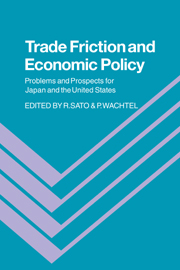Book contents
- Frontmatter
- Contents
- Foreword by Richard R. West
- Preface
- List of contributors
- 1 Introduction
- Part I Sources of trade friction
- 2 Restructuring the Japanese economy from a global perspective
- 3 Is the Japan problem over?
- 4 The Japanese–U.S. trade friction: some perspectives from the Japanese business community
- 5 Industrial policy in Japan: overview and evaluation
- Part II Macroeconomic policy
- Part III Trade policy
- Index
4 - The Japanese–U.S. trade friction: some perspectives from the Japanese business community
Published online by Cambridge University Press: 05 February 2012
- Frontmatter
- Contents
- Foreword by Richard R. West
- Preface
- List of contributors
- 1 Introduction
- Part I Sources of trade friction
- 2 Restructuring the Japanese economy from a global perspective
- 3 Is the Japan problem over?
- 4 The Japanese–U.S. trade friction: some perspectives from the Japanese business community
- 5 Industrial policy in Japan: overview and evaluation
- Part II Macroeconomic policy
- Part III Trade policy
- Index
Summary
Introduction
The allegation that Japan's economic and trade behavior is unfair seems fairly widespread in the United States. This assessment, I think, stems at least in part from an American tendency to seek quick solutions and to get irritated when the situation fails to develop as they see fit. And when this happens, Americans all too quickly point an accusing finger at Japan.
Such accusations are particularly puzzling in the absence of any consensus as to what constitutes “unfair” trade practices. It is useful, therefore, to examine exactly what Americans mean by “unfair” trade practices. Three possible definitions come to mind. First, the General Agreement on Tariffs and Trade (GATT) and other international rules constitute one yardstick to measure whether or not someone is in violation of the rules of the game.
Informed Americans, however, know that average tariff rates are low in Japan by international standards and other barriers are also considerably reduced and will dismiss unfair trade allegations as measured by this yardstick as simple misunderstanding.
The second yardstick is the principle of reciprocity. The principle of reciprocity requires that the same market conditions enjoyed by Japanese products and services in the American market be provided to American products and services in the Japanese market. Should Japan be considered an unfair trading partner by this measure, substantial trade friction would readily develop. In deciding the right and wrong of such an assertion, it is therefore most important that both sides exercise pragmatic judgment based on concrete examples.
The third yardstick concerns the presence of bilateral trade imbalances. The typical argument runs as follows: The U.S. trade imbalance with Japan is already enormous.
- Type
- Chapter
- Information
- Trade Friction and Economic PolicyProblems and Prospects for Japan and the United States, pp. 45 - 49Publisher: Cambridge University PressPrint publication year: 1987



